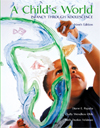 |
1 |  | 
According to diaries of going back to the sixteenth century, parents in those days |
|  | A) | treated children as miniature adults |
|  | B) | subjected children to harsh discipline and abuse |
|  | C) | were concerned about weaning and teething |
|  | D) | took children's illness or death in stride, since it was so common |
 |
 |
2 |  | 
The goals of child development as a discipline include all but which of the following? |
|  | A) | description |
|  | B) | explanation |
|  | C) | prediction |
|  | D) | compensation |
 |
 |
3 |  | 
The organismic model of development sees people as |
|  | A) | machines |
|  | B) | active initiators of development |
|  | C) | reactors to external forces |
|  | D) | blank slates |
 |
 |
4 |  | 
According to Freud's theory, the chief source of pleasure during the phallic stage is the |
|  | A) | mouth |
|  | B) | anus |
|  | C) | genitals |
|  | D) | superego |
 |
 |
5 |  | 
In Bronfenbrenner's terminology, the interlocking systems that contain the developing child compose the |
|  | A) | microsystem |
|  | B) | mesosystem |
|  | C) | exosystem |
|  | D) | macrosystem |
 |
 |
6 |  | 
In Freud's theory, the id is |
|  | A) | present at birth |
|  | B) | not developed until infants recognize that they are separate beings |
|  | C) | replaced by the ego |
|  | D) | a source of gratification |
 |
 |
7 |  | 
The "reality principle" refers to the |
|  | A) | superego |
|  | B) | ego |
|  | C) | id |
|  | D) | defense mechanisms |
 |
 |
8 |  | 
In Erikson's theory, the "virtue" developed during infancy is |
|  | A) | trust |
|  | B) | hope |
|  | C) | attachment |
|  | D) | obedience |
 |
 |
9 |  | 
Learning theories stress |
|  | A) | cognitive stages |
|  | B) | developmental changes |
|  | C) | hereditary influences |
|  | D) | environmental influences |
 |
 |
10 |  | 
The learning perspective includes |
|  | A) | cognitive-stage theory |
|  | B) | sociocultural theory |
|  | C) | behaviorism |
|  | D) | information-processing approach |
 |
 |
11 |  | 
In operant conditioning, negative reinforcement is |
|  | A) | withdrawal of a privilege |
|  | B) | withdrawal of an aversive event |
|  | C) | another term for punishment |
|  | D) | generally ineffective |
 |
 |
12 |  | 
Social-learning theory regards the learner as |
|  | A) | active |
|  | B) | molded by the environment |
|  | C) | influenced mainly by maturation |
|  | D) | influenced mainly by reinforcement and punishment |
 |
 |
13 |  | 
The term scheme is associated with |
|  | A) | Sigmund Freud |
|  | B) | Erik Erikson |
|  | C) | Jean Piaget |
|  | D) | Lev Vygotsky |
 |
 |
14 |  | 
Which of the following is a neo-Piagetian theorist? |
|  | A) | Jean Baker Miller |
|  | B) | Robbie Case |
|  | C) | Alfred Binet |
|  | D) | John Dewey |
 |
 |
15 |  | 
Cindy, age 8, has almost mastered the multiplication tables but is having trouble with some combinations. According to Vygotsky's theory, her parents should: |
|  | A) | insist on daily practice, and test her until she gets a perfect score |
|  | B) | leave her alone, since she will learn on her own when she is ready |
|  | C) | give plenty of praise to build her self-esteem |
|  | D) | give hints and ask leading questions to help her get the answers she can't get by herself |
 |
 |
16 |  | 
All but which of the following are self-reports? |
|  | A) | diary |
|  | B) | interview |
|  | C) | questionnaire |
|  | D) | blood test |
 |
 |
17 |  | 
A correlation describes |
|  | A) | cause and effect |
|  | B) | direction and magnitude of a relationship between variables |
|  | C) | practical implications of a relationship between variables |
|  | D) | which variable in an experiment is dependent and which is independent |
 |
 |
18 |  | 
Which of the following can be used to establish a causal relationship? |
|  | A) | case study |
|  | B) | laboratory observation |
|  | C) | experiment |
|  | D) | any of the above |
 |
 |
19 |  | 
Which kind of experiment can be used to study environmental effects on identical twins separated at birth? |
|  | A) | laboratory experiment |
|  | B) | field experiment |
|  | C) | natural experiment |
|  | D) | none of the above; experimentation on human beings is unethical |
 |
 |
20 |  | 
A drawback of longitudinal research is |
|  | A) | attrition |
|  | B) | confounding developmental effects with cohort effects |
|  | C) | tendency for participants to do more poorly in later tests |
|  | D) | tendency to mask individual differences |
 |



 2002 McGraw-Hill Higher Education
2002 McGraw-Hill Higher Education